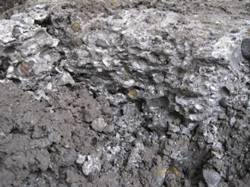
The risks of simply being in London include faulting, obstructions and the presence of sensitive structures. Knowledge of faulting in London is changing with the ground investigations from large projects like Crossrail. In the 1990s when the route for Crossrail was first being planned, it was the route only crossed one major faulted area (Northern Boundary Fault). Crossrail has worked with BGS to produce a three-dimensional block model for Farringdon Station which indicated three main sets of faults with varying degrees of uncertainty. Additional phases of ground investigation have not only targeted and reduced these areas but also indicated additional faults in each set.
Image: A concretion in the Harwich Formation
The detailed logging of borehole samples and cores has helped to define faults across the entire route. For example, an additional eight faults have been discovered in the Chalk alone! The recently discovered Plaistow Graben has now been extended south west to cross the Crossrail route near Isle of Dogs. Knowing where faults lie is important for two reasons. First, ground conditions can change across a fault. This is particularly important for SCL construction, as changes from clay to sand, especially water bearing sand, can affect excavation stability, the potential for base heave and dewatering requirements.
Second, faulting rarely occurs as a single plane; more usually it is a series of fractures that breaks up the ground and creates voids, resulting in an increase in secondary permeability decreased excavation stability and greater transmission of ground movements. The fault zone can form a preferential path for groundwater flow along it or form a barrier to water flow across it. These flows can have a significant influence on the development and performance of dewatering schemes, potentially leading to differential settlement across fault zones or additional dewatering requirements. Also, the broken ground contains sheared blocks that can fall into excavations. Not only does this cause over-break, but it is a potential safety hazard for the workforce. It has been a feature of excavations in London Clay with miners traditionally referring to the blocks as greasy backs
London has a long history which records much of our technological development. Hydraulic and pneumatic power networks for lift rams, wells and all kinds of deep foundations remain in the ground even when the original aboveground structure has long gone. A team of people have scoured numerous public and private archives to collect the available information, confirm the nature of any clashes and provide any mitigation measures. Records of these obstructions can vary from detailed to non existent, including duplicated and erroneous data. Safeguarding procedures through council planning applications reduces the risk of clashes with very recent developments.